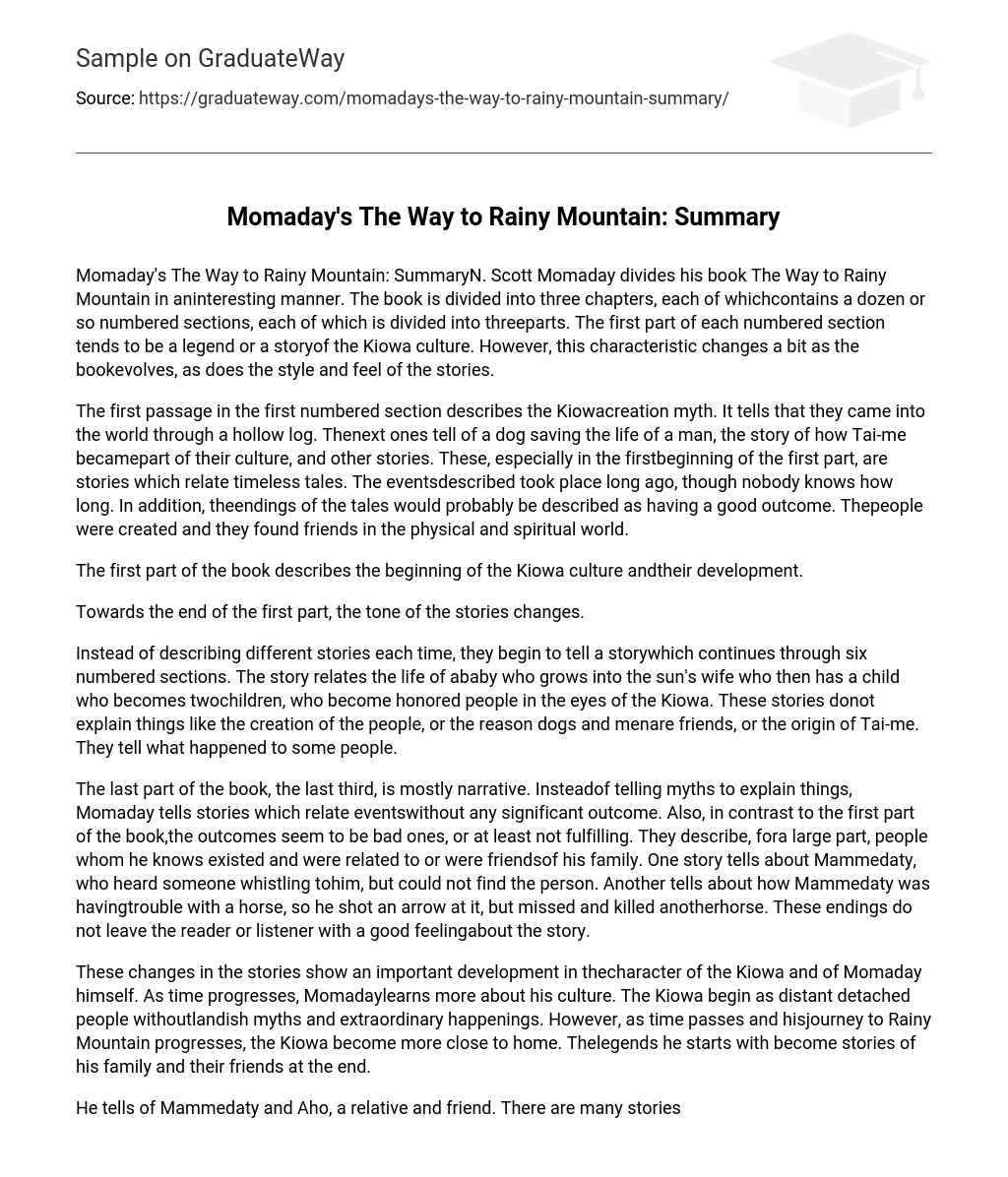N. Scott Momaday divides his book The Way to Rainy Mountain in aninteresting manner. The book is divided into three chapters, each of whichcontains a dozen or so numbered sections, each of which is divided into threeparts. The first part of each numbered section tends to be a legend or a storyof the Kiowa culture. However, this characteristic changes a bit as the bookevolves, as does the style and feel of the stories.
The first passage in the first numbered section describes the Kiowacreation myth. It tells that they came into the world through a hollow log. Thenext ones tell of a dog saving the life of a man, the story of how Tai-me becamepart of their culture, and other stories. These, especially in the firstbeginning of the first part, are stories which relate timeless tales. The eventsdescribed took place long ago, though nobody knows how long. In addition, theendings of the tales would probably be described as having a good outcome. Thepeople were created and they found friends in the physical and spiritual world.
The first part of the book describes the beginning of the Kiowa culture andtheir development. Towards the end of the first part, the tone of the stories changes.
Instead of describing different stories each time, they begin to tell a storywhich continues through six numbered sections. The story relates the life of ababy who grows into the sun’s wife who then has a child who becomes twochildren, who become honored people in the eyes of the Kiowa. These stories donot explain things like the creation of the people, or the reason dogs and menare friends, or the origin of Tai-me. They tell what happened to some people.
The last part of the book, the last third, is mostly narrative. Insteadof telling myths to explain things, Momaday tells stories which relate eventswithout any significant outcome. Also, in contrast to the first part of the book,the outcomes seem to be bad ones, or at least not fulfilling. They describe, fora large part, people whom he knows existed and were related to or were friendsof his family. One story tells about Mammedaty, who heard someone whistling tohim, but could not find the person. Another tells about how Mammedaty was havingtrouble with a horse, so he shot an arrow at it, but missed and killed anotherhorse. These endings do not leave the reader or listener with a good feelingabout the story.
These changes in the stories show an important development in thecharacter of the Kiowa and of Momaday himself. As time progresses, Momadaylearns more about his culture. The Kiowa begin as distant detached people withoutlandish myths and extraordinary happenings. However, as time passes and hisjourney to Rainy Mountain progresses, the Kiowa become more close to home. Thelegends he starts with become stories of his family and their friends at the end.
He tells of Mammedaty and Aho, a relative and friend. There are many stories hecan relate about each of them. This shows that Momaday has found the truemeaning of the Kiowa legends. While the myths remain supernatural and explainkey points of their being, the stories are about people. While some stories maynot be completely true, they are based on the past of the tribe.
The stories of the last part do not describe dogs or spiders talking topeople, or the sun wedding a woman. They describe things which are easilyconceivable, even to people who do not understand the Kiowa’s beliefs. The firstpassage of the last numbered section even describes the location of something bysaying that it is “East of my grandmother’s house.” Momaday has become part ofthe Kiowa, telling stories which have been told only a few times before, orpossible never at all, where they can join the others.





